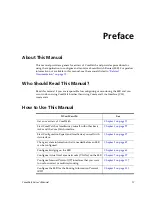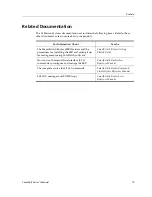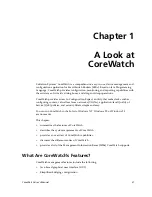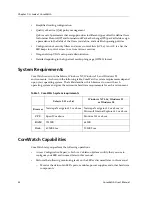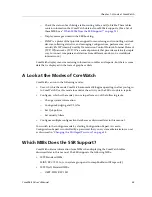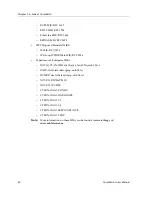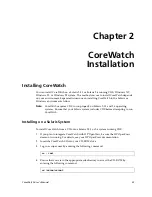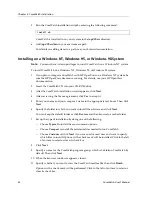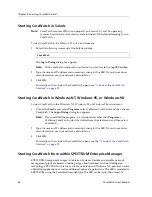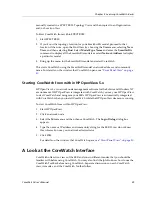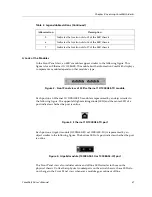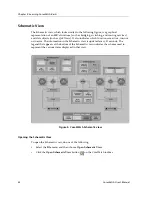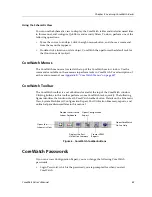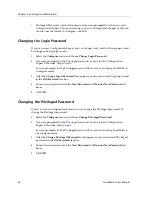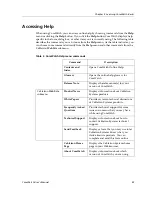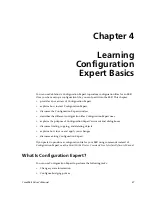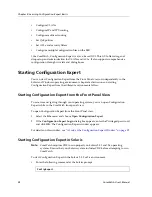
CoreWatch User’s Manual
23
Chapter 1: A Look at CoreWatch
–
Check the status of each bridge table, routing table, and QoS table. These tables
contain information that CoreWatch obtains from MIBs it supports. (For a list of
these MIBS, see
“Which MIBs Does the SSR Support?” on page 23
.)
–
Display messages stored in the SSR boot log.
–
SNMP is a protocol that provides support for monitoring and controlling network
devices, collecting statistics, and managing configurations, performance, and
security. SNMP is mainly used by Transmission Control Protocol/Internet Protocol
(TCP/IP) networks. (TCP/IP is a suite of protocols that provide a relatively simple
way to connect computers and devices from different vendors on a worldwide
internetwork.)
CoreWatch displays most monitoring information in tables and reports, but there is some
data that is displayed in the form of graphs or dials.
A Look at the Modes of CoreWatch
CoreWatch can run in the following modes:
•
User, which is the mode CoreWatch automatically begins operating in after you log in
to CoreWatch. Use this mode to monitor the activity on the SSR or to obtain reports.
•
Configure, which is the mode you use to perform any of the following tasks:
–
Change system information
–
Configure bridging and VLANs
–
Set QoS policies
–
Set security filters
•
Configure multiple configuration databases as discussed later in this manual
You switch to the configure mode by starting Configuration Expert. Access to
Configuration Expert is controlled by a password that your system administrator can set
as discussed in
“Changing the Privileged Password” on page 34
.
Which MIBs Does the SSR Support?
CoreWatch obtains information from MIBs when displaying the CoreWatch tables
discussed later in this manual. The SSR supports the following MIBs:
•
IETF Standard MIBs:
MIB2/RFC 1213 (r/w to system group and to snmpEnableAuthTraps only)
•
IETF Draft Standard MIBs:
–
OSPF-MIB/RFC 1850
Summary of Contents for CoreWatch
Page 1: ...CoreWatch User s Manual 9032564 04...
Page 2: ...Notice 2 CoreWatch User s Manual...
Page 20: ...Preface 20 CoreWatch User s Manual...
Page 64: ...Chapter 5 Changing System Settings 64 CoreWatch User s Manual...
Page 86: ...Chapter 6 Configuring SSR Bridging 86 CoreWatch User s Manual...
Page 106: ...Chapter 7 Configuring VLANs on the SSR 106 CoreWatch User s Manual...
Page 206: ...Chapter 12 Configuring QoS on the SSR 206 CoreWatch User s Manual...
Page 246: ...Chapter 13 Configuring Security on the SSR 246 CoreWatch User s Manual...
Page 363: ...CoreWatch User s Manual 363 Chapter 16 Configuring Routing Policies on the SSR 9 Click OK...
Page 364: ...Chapter 16 Configuring Routing Policies on the SSR 364 CoreWatch User s Manual...
Page 370: ...Chapter 17 Checking System Status 370 CoreWatch User s Manual...
Page 390: ...Chapter 18 Monitoring Real Time Performance 390 CoreWatch User s Manual...
Page 396: ...Chapter 19 Checking the Status of Bridge Tables 396 CoreWatch User s Manual...
Page 430: ...Chapter 20 Checking the Status of Routing Tables 430 CoreWatch User s Manual...
Page 442: ...Chapter 22 Obtaining Reports 442 CoreWatch User s Manual...
Page 456: ...Appendix B CoreWatch Menus 456 CoreWatch User s Manual...









